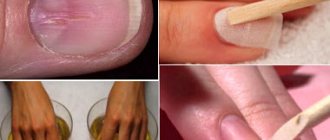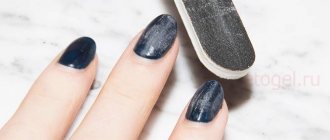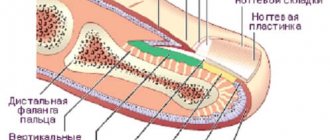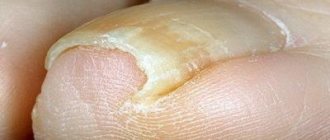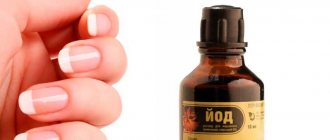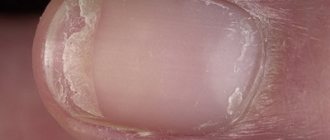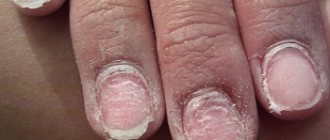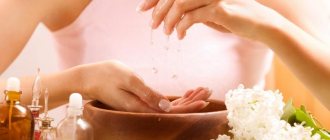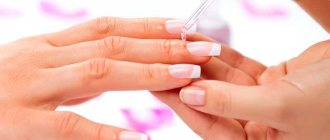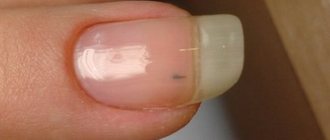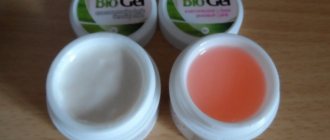general description
Nail fungus (onychomycosis) is a nail infection caused by pathogenic fungi (usually Tinea rubrum).
Nail fungus affects approximately 10% of the population. The prevalence increases with age (up to 30% after 65 years), which may be due to the appearance of predisposing factors such as vascular diseases of the extremities, metabolic diseases, osteoarthropathy, and slow nail growth. More common among men.
A provoking factor may be the use of tight shoes, which leads to poor circulation and damage to the structures of the nail and skin. Nail fungus on the feet develops 3–7 times more often than on the hands. It is possible to become infected with a fungus from a sick person.
Case study
Patient A. came for an initial appointment in November 2009 with complaints of changes in the structure and color of nails, itching in the groin area. He has been ill, according to him, for about six years. Treatment with Orungal, Lamisil and Batrafen Lac did not bring relief. The patient experienced great anxiety and even despair when the process moved to his fingernails, which became the decisive impetus for visiting the mycologist. Upon examination, the nails of A.'s big toes are completely affected: thickened, crumbling, yellow in color. Detachment of the epidermis, itching, and cracks in the skin between the fingers were also observed. On the first and fifth fingers of the right hand there are yellow spots, thickening and detachment from the nail bed. Inguinal region: large, clearly defined scaly plaques, excoriations.
At the beginning of December, the results of A.'s tests were completely ready. Using an accurate history, physical examination and laboratory methods, eczema, onychodystrophy, psoriasis of skin folds, erythrasma and candidiasis of skin folds - severe skin diseases with identical external signs - were excluded. To confirm the fungal etiology of this process, material was taken from the nail plates and the skin of the groin area. In both cases, microscopy revealed fungal mycelium, and the exact pathogen was identified in culture - Trichophyton rubrum.
Already at the first examination, it became obvious that for a successful recovery the patient needed a therapeutic spectrum, including broad external therapy, therapy with systemic antimycotics, and therapy for dystrophic processes in the nail bed that arose as a result of the duration of the disease. In addition, recommendations were given aimed at improving microcirculation and improving blood flow to the nail plates, which should ensure the delivery of the necessary nutrients, also prescribed to accelerate nail growth and reduce treatment time.
The third visit was scheduled for A. at the end of February. Upon examination, a significant improvement in condition was observed. So, in particular, in the groin area the skin is absolutely healthy, blood biochemistry tests are normal. The treatment regimen has been adjusted (in the process this must be done once every two months).
The last visit took place at the end of April 2010. Based on the results of the examination and repeated tests (blood biochemistry and microscopy), patient A. is absolutely healthy.
Clinical picture
Fungal nail infections are characterized by changes in transparency and color, white or yellow spots on the nails, transverse stripes, separation, and thickening of the affected nail plates. Pain in the area of injury and an unpleasant odor (25%) may also bother you.
| Nail fungus: photo | ||
Forms of nail fungus:
- distal-lateral - penetration of a fungal infection under the nail, starting from the angle of connection with the nail bed;
- proximal - primary lesion of the nail fold;
- superficial - the spread of a fungal infection to the entire surface of the nail plate.
Folk recipes
Having studied many opinions of people on the Internet, among the abundance of recipes offered by traditional medicine, we will highlight the most effective and inexpensive ways to get rid of onychomycosis.
Apple vinegar
This component is especially popular due to its availability and ease of use.
Apple cider vinegar is a storehouse of nutrients . Its effect on fungal mycelium is to change the acidity of the environment.
Due to its increase, unsuitable conditions are created for the growth and development of the fungus.
Traditional medicine knows dozens of recipes for onychomycosis, which are based on vinegar. Let's look at a few of them:
- bath _ To prepare it, mix 3 liters of warm water with 1 glass of vinegar. Keep your hands or feet in this composition for 20 minutes every day for a month;
- applications . The pure product is applied to a cotton pad and applied to the affected area for 15 minutes. Frequency of use – no more than 3 times a week;
- compress _ A vinegar-oil mixture is prepared for it in a 1:1 ratio. It is applied to a cotton-gauze swab and fixed on the sore nail with cling film overnight.
The above procedures can be used in parallel with each other.
Note! Vinegar can also be used to disinfect shoes or carry out wet cleaning in a house where a fungal infection carrier lives.
Garlic compress
Garlic has an antibacterial and fungicidal effect, thanks to which it is actively used in the fight against mycotic infections of the skin and its appendages.
most effective way to influence the source of the disease is a garlic compress .
It is prepared quite simply: 2 large cloves are passed through a special press or crushed to a pasty state in any other convenient way.
The resulting mass is applied to problem nails, avoiding the surrounding skin, and fixed on the finger with a gauze bandage, over which a thick sock or glove is put on.
Leave the compress on all night, then wash off the residue with warm water.
Tea tree essential oil
Tea tree oil is a powerful natural antiseptic , for which it is widely used in the treatment of dermatological diseases.
In its pure form, it is rubbed into the nail at least 3 times a day for 1.5-2 months every day.
A ready-made pharmaceutical product is added to the compositions of therapeutic baths both for therapeutic purposes and to prevent the spread of fungal infection to healthy areas of the feet or hands.
In advanced cases, lotions are appropriate. A cotton pad is soaked in oil and applied to the site of infection for 4-8 hours.
Note! Essential oil is used exclusively externally.
Baths with celandine
Celandine is considered one of the most potent herbal antimycotics due to its aggressive action against various fungi.
Using celandine juice in its pure, undiluted form, there is a high risk of getting burned .
A safe method of including this plant in antimycotic therapy is to add it to medicinal baths for hands or feet.
For a liter of boiling water you will need 4 tbsp. l. dry grass. The infusion is kept in a thermos for 3 hours, after which it is diluted in 2 liters of cool water, bringing the temperature to 37-40 degrees.
The duration of the bath is 20 minutes.
Video recipe: How to cure nail fungus with folk remedies
Recipe by mycologist L.R. Alekseeva, tested by people who suffered from onychomycosis. Real experience, has positive reviews.
Peppermint with sea salt
A bath with sea salt and peppermint oil has bactericidal properties, in addition, it copes well with the unpleasant odor that occurs with mycosis.
To carry out the treatment procedure you will need:
- 3 liters of warm water.
- 100 grams of sea salt.
- 7 drops of peppermint essential oil.
Soak your feet in the prepared solution for 30 minutes.
Chaga mushroom
Birch chaga has many beneficial properties applicable to the treatment of onychomycosis.
It not only suppresses fungal infection due to the content of phytoncides, but also increases local immunity .
Also, the microelements contained in chaga promote tissue regeneration, due to which a healthy nail plate grows faster.
An alcohol infusion for external use is prepared from 10 tbsp. dry chaga birch powder and 0.5 liters of vodka.
Having combined these components in a bottle, it is sent to a dark place for 10 days.
The resulting infusion is applied to the affected areas at least 4-5 times a day until the healthy plate grows completely.
Chaga is also to strengthen the body’s defenses in order to naturally resist mycotic infections. 2 tbsp. l. chopped mushroom is poured with boiling water and left in a thermos for 4 hours.
The finished product is consumed an hour after meals, half a glass 2-3 times a day for 3 weeks.
This is interesting! The best time to collect this medicinal crop is early spring or late autumn. For treatment, use the brown part located in the middle of the mushroom.
Baking soda and propolis
A standard soda bath in combination with propolis tincture will speed up the healing process by quickly relieving inflammation and eliminating pathogenic flora.
In addition, it is advisable to carry out this procedure immediately before applying pharmaceutical products, since soda softens the tissues, making them more susceptible to the penetration of drugs. 4 tbsp. l. Heaped soda and 10 drops of alcohol tincture of propolis are dissolved in 2 liters of warm water.
The procedure is repeated every day at night until a healthy nail plate grows.
Using a bow
In its action against mycoses, onions are similar to garlic.
The onion family, to which both of these representatives belong, contains a large number of phytoncides - plant antibiotics that successfully cope with various pathogens.
To achieve positive results, it is enough to rub the nail plates with a cut of the onion several times a day or leave onion pulp on them for 1 hour, 2 times a day.
Horseradish root
Horseradish root lotions have long been used in the treatment of fungal diseases. The juice from the root of this plant has a disinfecting ability, due to which a fungistatic effect is achieved.
The preparation of the remedy is simple - the root is grated on a fine grater. The paste, without squeezing, is applied to the foci of the disease 2 times a day for 2-3 hours.
On top of it, the finger is wrapped in a bandage, folded several times.
Calamus root
The rhizomes of Tatar cinquefoil or popularly calamus are endowed with a huge number of biologically active substances.
In the treatment of mycoses, calamus is valued for the presence of phytoncides and iodine, which have pronounced antifungal activity.
Ready-to-use roots can be purchased at a pharmacy at an affordable price.
Next, they are crushed to a powdery state, mixed with vegetable oil until a homogeneous substance is obtained and infused in a glass container for a week in a place protected from sunlight.
Applications are carried out daily for at least 1 month.
Iodine
This antiseptic, known since childhood, is suitable not only for disinfecting wounds, but also for eliminating onychomyosis on the hands or feet.
You can find many folk recipes that use iodine in the literature. The simplest of them is to lubricate the nail plate with a 5% solution.
This treatment method shows good results , but is not suitable for many because it changes the color of the nail, making it look unattractive.
The beneficial properties of iodine can be extracted by combining it with other benefits of alternative medicine: soda, herbal decoctions and other components.
Foot baths with soda and iodine are suitable for daily use. Just 7-10 drops of antiseptic in a 3-liter container filled with soda solution will have a bactericidal effect and will not stain the skin.
Sea salt
Endowed with more than a dozen minerals, sea salt has a positive effect on skin condition.
And treats onychomycosis on the arms and legs.
It is used for baths and added to medicinal pastes and lotions.
Regular use of salt strengthens local immune forces, disinfects tissues, and promotes their regeneration.
Note! Dead Sea salts are considered the most useful, since their composition is maximally enriched with mineral compounds.
Herb tea
Herbalists advise combining external treatment of onychomycosis with ingestion of herbal teas.
They allow you to stimulate the immune system and help remove toxins formed in the body during the life of fungi.
You can prepare healing tea yourself or purchase a ready-to-drink product at a pharmacy called “ Monastic herbal tea .”
If you decide to prepare a herbal mixture for oral administration at home, mix the following herbs in equal proportions:
- chamomile;
- oak bark;
- calendula;
- sagebrush;
- peppermint;
- Echinacea.
For 200 ml of boiling water you need 2 tsp. with a pile of dried flowers, the tea is infused for at least 20 minutes before drinking.
Treatment of nail fungus
- Local application of antimycotic ointments, gels, varnishes.
- Systemic antimycotic drugs.
- In case of complete and deep destruction of the nail - surgical removal.
Treatment is prescribed only after confirmation of the diagnosis by a medical specialist.
Essential drugs
There are contraindications. Specialist consultation is required.
| 1 | Amorolfine (Loceryl) is an antifungal drug for external use. |
Dosage: for nail fungus, the drug is applied to the affected areas of the nails of the fingers or toes 1-2 times a week. Treatment continues until the nail is restored and the lesion is healed. The course of therapy takes on average 6 months to restore fingernails and 9-12 months to restore toenails.
Before applying the drug, if possible, it is necessary to remove the affected areas of the nail using the nail file included with the drug. Afterwards, the nail is treated with alcohol and degreased with a cotton swab. These steps must be repeated immediately before each application of the drug. The solution is applied to the affected area using a spatula, then wait until the solution dries. This procedure is repeated for all affected nails.
The spatula must be lowered into the solution, then pull the spatula out of the bottle without touching the neck. Immediately after using the drug, the bottle must be tightly closed, after wiping the neck with a cotton swab. The product should dry in about 3 minutes. After use, the spatula must be wiped with a cotton swab. Avoid contact of nails with the applied solution and the tampon.
| 2 | Fluconazole (Diflucan) is an antifungal drug. |
Dosage: For nail fungus, the recommended dosage is 150 mg orally once a week. Therapy must be continued until a new nail grows. Nail regrowth takes 3 to 6 months for the hands and 6 months to a year for the toes. The growth rate depends on various factors and individual characteristics of the organism. After completing the full course of treatment, a changed shape of the nails may be observed.
Pills
Systemic treatment is used when the disease begins to progress - until this point, local therapy is mainly used. For onycholytic mycosis, an antibiotic (Griseofulvin) is prescribed orally, combined with an external keratolytic agent. Griseofulvin is taken with 1 tsp. vegetable oil 250 mg up to 3 times a day, and at the same time use varnishes Batrafen, Lotseril, etc. In other situations, azoles and allylamines are prescribed, the price picture for which looks like this:
| Name | Price | Name | Price |
| Mycozoral | 655 rub. | Irunin | 779 rub. |
| Lamisil | 2144 rub. | Terbinafine | 221 rub. |
| Ketoconazole | 280 rub. | Fluconazole | 32 rub. |
Azoles
The most extensive group of drugs for the treatment of onychomycosis are azole-based drugs: they provide a fungicidal and fungistatic effect. Firstly, they suppress the synthesis of the fungal cell membrane, and, secondly, when accumulated, they lead to the death of all pathogenic microorganisms. They are prescribed mainly against yeast-like fungi and dermatomycetes. Azoles are used up to 3 times per day, the course lasts 4 weeks. The most effective:
- ketoconazole (Mikozoral, Ketoconazole) - drink 1 tablet per day;
- intraconazole (Mikonihol, Irunin) - drink 2 capsules a day, treatment can last six months.
Allylamines
The ability to block fungal growth in allylamines is combined with the ability to rupture the cell membrane, which destroys the microorganism. Some of them affect all types of fungi, while naftifine is used primarily against additional bacterial infections, but it is produced only for external use. Allylamines penetrate into the thickness of the nail plate and give a prolonged effect. Duration of treatment is up to 3 months. There is only 1 remedy - Terbinafine (Lamisil, Terbinafine):
- efficiency is 94%;
- course of treatment up to 3 months;
- intake – 250 mg after meals once a day;
- The drug should not be used during breastfeeding; a high load on the liver cannot be ruled out.
Drugs to improve blood circulation in small vessels of the extremities
In order to increase the effectiveness of the main therapy, you can also take a course of medications that affect blood circulation in the fingers and toes: they help transport the substances contained in antifungal drugs in their original concentration. Additionally, the treatment period is reduced, since a healthy nail plate grows faster. Make sense:
- Trental;
- Agapurin;
- Doxium;
- A nicotinic acid.
- How to gain weight for a woman at home. Diet and menu for quick weight gain
- Clothes storage - proper organization of space in a closet or room
- Treatment of parasites with birch tar
Incidence (per 100,000 people)
| Men | Women | |||||||||||||
| Age, years | 0-1 | 1-3 | 3-14 | 14-25 | 25-40 | 40-60 | 60 + | 0-1 | 1-3 | 3-14 | 14-25 | 25-40 | 40-60 | 60 + |
| Number of sick people | 0.001 | 5 | 25 | 231 | 231 | 411 | 586 | 0.001 | 3 | 21 | 196 | 196 | 385 | 398 |
Treatment at home
There are various methods of self-treatment of onychomycosis. For this purpose, pharmacy and folk remedies are used. However, consulting a doctor is recommended before using any of them.
The duration of treatment depends on the degree of damage and the type of fungal infection. Most often, a positive effect can be achieved after a few weeks. To minimize the likelihood of relapse, the course of treatment must be completed completely.
Pharmacy products
Local therapy can only be used at the initial stage of the disease.
The most popular drugs are Ketoconazole, Griseofulvin, Terbinafine, Lamisil, Nizoral and Itraconazole.
We recommend reading: Mint tea during pregnancy - is it possible or not?
The use of such drugs rarely causes side effects or allergic reactions.
Traditional therapy
To treat onychomycosis, you can also use medicinal plants with an antifungal effect. Many doctors approve of their use as primary and additional therapy, as well as to prevent the recurrence of fungus.
The most effective means include:
- Garlic. One of the most effective remedies is an alcoholic infusion of garlic. To prepare it, you need to pour 50 ml of alcohol into the head of garlic. Leave for 4-5 days. Apply the resulting infusion to the affected nails, avoiding contact with the skin. You can also make a garlic compress, for the preparation of which you need to grind the garlic and mix it in equal proportions with water. Moisten a cotton swab and apply to the affected nail plate for half an hour;
- Propolis. The use of propolis stimulates the falling off of the affected nail plate and the growth of a new one. It is necessary to apply the propolis infusion to the nail and leave for 15 minutes;
- Salt with mint. Grind fresh mint leaves and add a little water. Add an equal amount of table or sea salt. This product can be used to treat both the nail plate and the affected skin around it;
- Celandine. Using celandine, you can prepare an effective bath for your hands or feet. You need to pour 5 tbsp. l. dry celandine leaves with a liter of boiling water. Leave and cool to room temperature. The procedure time should be 10-15 minutes;
- A series. Another excellent remedy for preparing antifungal baths is a series. It is necessary to pour 50 g of dry string with 600 ml of water. Boil for 20 minutes, strain and use for baths. Recommended procedure time is 20 minutes;
- Tea mushroom. An effective remedy for the treatment of early stage onychomycosis. It is necessary to apply kombucha to the infected nail plate, wrap it in film and leave for half an hour. Carry out the procedure twice a day;
- Lilac. To make a compress on infected nails, you should prepare an infusion of lilac. To do this, pour 15 g of fresh lilac flowers with 100 ml of alcohol. Infusion time is a week in a dark place. Soak a sponge or cotton wool in the infusion and apply it to infected and healthy nails. It is an excellent therapeutic and prophylactic remedy.
During the treatment of onychomycosis, it is necessary to pay special attention to the disinfection of shoes and gloves, as well as manicure accessories. If you do not use strong chemical disinfectants, the risk of re-infection with a fungal infection increases.
Prevention
Treatment of nail onychomycosis can take a long time and does not guarantee the absence of relapses. Therefore, it is important to follow the rules of prevention:
- observe personal hygiene standards;
- use only personal shoes both in public places and at home;
- maintain a healthy immune system;
- take antifungal drugs to prevent onychomycosis during a long course of antibiotics;
- wash hands and feet after swimming in open water;
- regular washing and airing of shoes, as well as changing socks;
- timely treatment of chronic diseases.
We recommend reading: How to remove bags under the eyes - folk recipes
Only compliance with preventive measures will allow you to cure nail onychomycosis once and for all.
